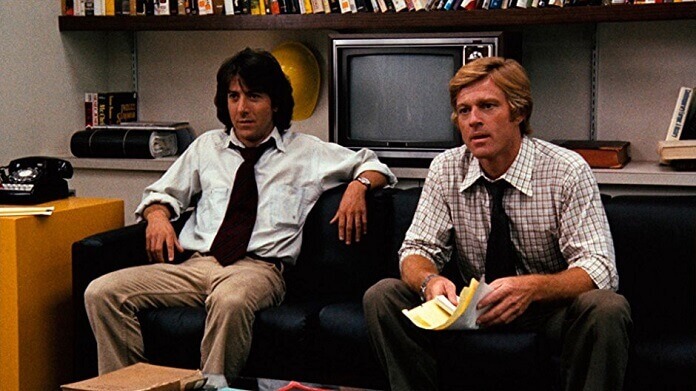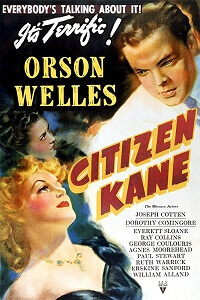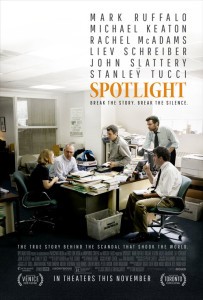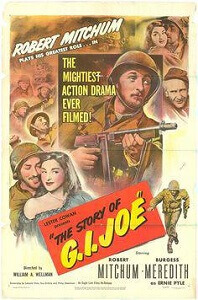
There may be a time when newspapers are a thing of the past, like typewriters, record players, and 8-track tapes. When news can be posted 24/7 to the Internet and stories can break on Twitter and trend in a flash, a physical newspaper that requires printing does seem a bit archaic. But there’s no denying that there’s a cinematic appeal to the newspaper biz. Since the earliest days of cinema to the present day, Hollywood has always loved a good newspaper story. Some films make heroes out of journalists; others look to the profession with cynicism while others still find it ripe for comedy.
Here’s a look at the 10 best American films about newspapers. To make this list the films have to be outstanding, they have to be about some aspect of the newspaper business (so not TV news like Network or Nightcrawler), and newspapers have to be key to the plot and not just some peripheral element. The list also reflects the diversity to be found in Hollywood’s newspaper films.
Top 10 Newspaper Films:
1. All the President’s Men (1976)
Alan J. Pakula’s film tops the list because it showcases both the craft of filmmaking and the newspaper business at their finest. The film follows Washington Post reporters Bob Woodward (Robert Redford) and Carl Bernstein (Dustin Hoffman) as they doggedly uncover the details of the Watergate scandal, which leads to President Richard Nixon’s resignation. The film effectively captures the dynamics of a working newsroom and conveys not just the satisfaction of getting a story right but also the long dull hours of research and investigation that leads to that story. William Goldman’s script is almost all dialogue and yet Pakula makes the film a tense thriller that rivets the audience.
If you want a perfect double bill in terms of historical narrative, watch Steven Spielberg’s The Post (about the Washington Post’s publishing of the Pentagon Papers after the courts ordered the New York Times to stop publishing articles based on those documents). The end of The Post flows seamlessly into the beginning of All the President’s Men.
2. Ace in the Hole (1951)
Billy Wilder’s gritty, cynical classic gets the second spot for offering the complete flip side to All the President’s Men. Kirk Douglas plays Chuck Tatum, a former big-city newspaperman with a drinking problem and a lousy record for holding onto a job. When his car breaks down, he inveigles his way into a small Albuquerque newspaper. He hungers to return to his former glory and seizes the opportunity to gain national attention when a man gets trapped in an old mine by a cave-in.
Knowing full well that there is an easy way to rescue the man, Tatum instead engineers a more complicated alternative that will keep the man trapped for days and thus allows Tatum to exploit the story to its fullest. The situation quickly escalates to a full-on media circus with tourists coming and paying admission to watch the rescue attempt.
Wilder is absolutely ruthless in his depiction of corrupt, sensational journalism and Douglas pulls no punches in playing Tatum. But Wilder isn’t just critical of Tatum; he also condemns the public that eats up stories like these that feed on the tragedies of others. The poor man in the cave-in is just about the only one who escapes Wilder’s savage attack. The film does not have one sentimental bone or cell in its body and its unflinching look at America’s dark underbelly has not lost any of its bite.
3. His Girl Friday (1940)
All right, time to lighten the tone with this Howard Hawks’ gem. The Ben Hecht-Charles MacArthur play The Front Page was the basis for the film and Hawks’ brilliant tweak was to change the gender of one of the lead characters from male to female so that newspaper editor Walter Burns and reporter Hildy Johnson could be played by Cary Grant and Rosalind Russell respectively. Now the relationship between the two could be complicated by having Burns and Johnson recently divorced. So not only is Burns mad that his best reporter is quitting the newspaper business to get married, but he’s also jealous that he’s been replaced romantically.
The play was adapted to the screen in 1931 (by Lewis Milestone with Adolph Menjou and Pat O’Brien) and 1974 (by Billy Wilder with Walter Matthau and Jack Lemmon). But Hawks’ version wins the prize for its fast-paced, cleverly gender-swapped screwball comedy perfection. It also provides a comedic view of an old-school newspaper.
4. Citizen Kane (1941)
The previous films all focus on reporters or reporters and their relationships to their editors. Orson Welles’ brilliant feature film directorial debut provides a portrait of a newspaper-publishing tycoon. Welles plays Charles Foster Kane, a character modeled after real-life publisher William Randolph Hearst. His Kane is brash, bold, arrogant and absolutely riveting. The film serves up multiple angles on the newspaper business because not only do we see how Kane runs his but also the framing device of the story has a reporter trying to find out what Kane’s dying word, “Rosebud,” means.
This film contains many memorable quotes about how Kane ran his newspaper. Early on we get a glimpse of his idealistic and noble intent for his paper. After remaking the front page four times he asks for a fifth to create something that is not merely a cosmetic makeover. He calls it a Declaration of Principles.
Kane: I will provide the people of this city with a daily paper that will tell all the news honestly. I will also…
Leland: That’s the second sentence you started with I.
Kane: People are going to know who is responsible. Now they are going to get the truth from The Inquirer and they are going to get it quickly and simply and entertainingly and no special interests are going to be able to interfere with that truth. I’ll also provide them with a fighting and tireless champion of their rights as citizens and as human beings. Signed Charles Foster Kane.
Later he rails in an argument: “The trouble is, you don’t realize you’re talking to two people. As Charles Foster Kane, who has 82,634 shares of Public Transit Preferred. You see, I do have a general idea of my holdings. I sympathize with you. Charles Foster Kane is a scoundrel. His paper should be run out of town. A committee should be formed to boycott him. You may, if you can form such a committee, put me down for a contribution of $1,000 dollars. On the other hand, I am the publisher of The Inquirer! As such, it’s my duty – and I’ll let you in on a little secret, it’s also my pleasure – to see to it that decent, hard-working people in this community aren’t robbed blind by a pack of money-mad pirates just because they haven’t anybody to look after their interests.”
But his noble crusading efforts eventually give way to darker less idealistic motives and that Declaration of Principles gives way to greed and ambition.
5. Sweet Smell of Success (1957)
Columnists are not the same as reporters and films usually treat them with less respect. In 1944, Clifton Webb brought the character of columnist Waldo Lydecker to wicked life in Laura. His character was supposedly inspired by real-life columnist and theater critic Alexander Wolcott. But a darker look at the world of a powerful columnist is at the center (I was going to say heart but there is no heart in this film) of Sweet Smell of Success.
Walter Winchell, a real-life tabloid columnist who wielded immense power during his long reign from the late 1920s to the 1950s, was likely the source of inspiration for Burt Lancaster’s unscrupulous but powerful Broadway columnist J.J. Hunsecker. Tony Curtis plays the slimy press agent always hungry for an inch of Hunsecker’s column space. This film is a kindred spirit to Ace in the Hole – bleak, scathing, uncompromising, and thoroughly riveting. And both stand the test of time well, their biting cynicism seeming to protect them from the kind of aging that more sentimental films suffer.
It was directed by Alexander Mackendrick with a script by playwright Clifford Odets and Ernest Lehman (based on Lehman’s novella). The film is ripe with delicious Hunsecker lines like, “You’re dead, son. Get yourself buried,” and “I’d hate to take a bite outta you. You’re a cookie full of arsenic.” This is nastiness at its finest.
6. Spotlight (2015)
Back to the more dignified side of journalism with another true story about good, old-fashioned investigative journalism. Writer-director Tom McCarthy turns to the real story of the Boston Globe as its editor and a team of reporters set off on a long and grueling journey to uncover the massive child molestation scandal and cover-up within the local Catholic Archdiocese. When the story broke it ended up rattling the cages of the entire Catholic Church. A good companion piece to All the President’s Men in terms of providing insight into how a newsroom operates and the challenges reporters face when trying to cover a story where no one wants to talk and the powers that be exert every pressure to maintain that silence.
7. Zodiac (2007)
Another of the true story-based journalism films, this one by David Fincher plays even more like a thriller because the story these characters are chasing involves a serial killer. In the late 1960s and early 1970s, someone identifying himself as the Zodiac Killer terrorizes Northern California with a series of random and brutal murders. The real-life story also inspired the film Dirty Harry.
The reporter is not the driving force of this film but rather an editorial cartoonist working at the San Francisco Chronicle. Robert Graysmith (played by Jake Gyllenhaal) wrote the book about the case. The film crossbreeds the police procedural with the newspaper film to come up with something original and disturbingly effective. In the interactions between Graysmith, police inspector David Toschi (Mark Ruffalo), and the suspects in the killings you can see the creepy groundwork for Mindhunter, a series Fincher executive produced and directed some episodes. The reporter in this film, Paul Avery, is played by Robert Downey, Jr. but it’s amateur sleuth Graysmith who drives the film. This is less about the day-to-day running of a newspaper but it shows how a newspaper can get pulled into its own story and how that can complicate reporting it.
8. Parallax View (1974)
It is probably no accident that All the President’s Men director Alan J. Pakula made this paranoid thriller just a couple of years before telling the story of The Post and breaking the Watergate Scandal. This fictional tale finds a reporter (played by Warren Beatty) deep in trouble when he proves too good at investigating a senator’s assassination and uncovers a vast conspiracy involving a multinational corporation. This film does not allow for any sense of victory at the end and it leaves you feeling powerless and angry. A classic example of the paranoid cinema of its time and Beatty gives us a character who is so driven to find the truth that he’s willing to risk his own life.
9. Story of GI Joe (1945)
There are a number of films (Under Fire, The Killing Fields, even the much lighter Almost Famous) that look to a single reporter and his determination to tell one particular story but to tell it fully. This is the best of the bunch because it is told with no frills or window dressing. Burgess Meredith plays Ernie Pyle, a war correspondent who joins the Army in order to tell the stories of ordinary men fighting in World War II. William A. Wellman directs with a steady, unsentimental sense of naturalism. He won the Pulitzer Prize in 1944 for his work.
10. It Happened One Night (1934)
And let’s end on a light, fun note with the screwball comedy It Happened One Night. Clark Gable is a reporter looking for a great story and he finds it in Claudette Colbert as an heiress on the run from the altar. This would go well on a double feature with Roman Holiday, which uses a similar plot setup. Both films show how a story can fall into a reporter’s lap and then raise questions of unethical practice as he dupes his subject into trusting him when she shouldn’t. Both films are delightful to watch and show the dangers of a journalist becoming too close to his story.
Bonus Picks: I want to mention Deadline USA (1952) for Humphrey Bogart’s performance and for having a lot of the footage for the fictional newspaper shot in the real press rooms of the New York Daily News. And this is a cheat because it was a made-for-TV movie, but no list of newspaper films can be complete without The Night Stalker (1972), which introduced us to Darren McGavin’s Carl Kolchak. The TV movie would inspire a TV show (that only lasted a season), Kolchak, that also starred McGavin as the title character. Kolchak had a knack for cases that had a supernatural or unexplainable element. Although the show dates a bit in terms of how it treats women and other minorities, McGavin’s performance is spot-on and great, and the stories were always inspired.









